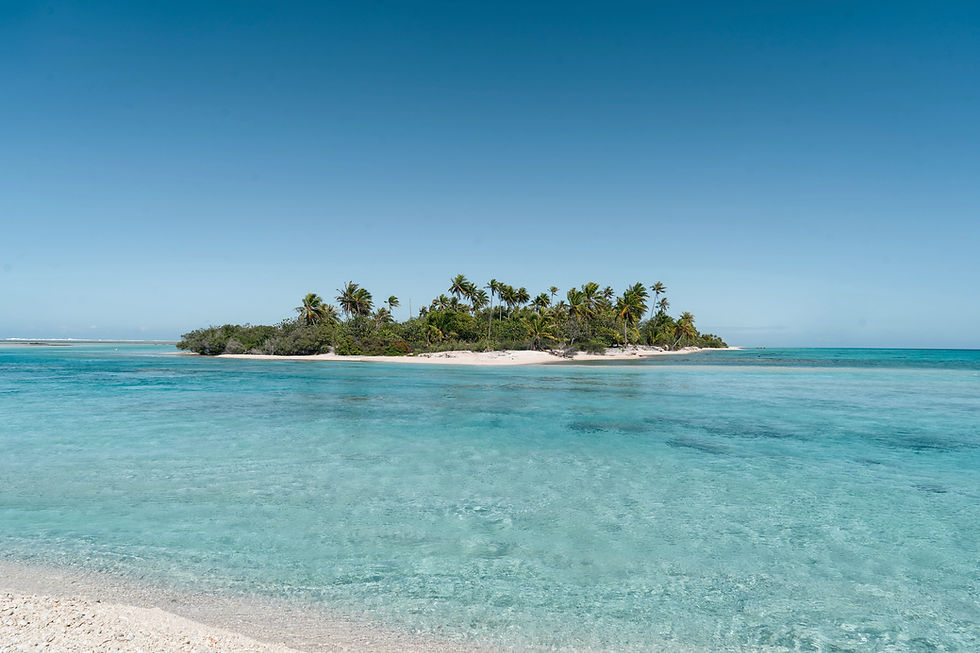Best time to travel to French Polynesia
- loureibel
- Aug 18
- 4 min read
Traveling to French Polynesia is an invitation to immerse yourself in pristine nature, rich culture, and pure, unfiltered luxury. Yet, to fully enjoy this experience, choosing the right time of year is essential. These sun-kissed, ocean-wrapped islands follow both a climate and cultural calendar that directly influence the quality of your stay. Understanding these seasonal rhythms allows you to live a more magical journey, whether under endless blue skies or amid vibrant local festivals.

Climate in French Polynesia: two main seasons
French Polynesia, nestled in the heart of the South Pacific, enjoys a warm maritime tropical climate year-round.
However, the region is defined by two distinct seasons:
The dry or “cool” season: From May to October, with temperatures ranging between 24°C and 28°C (75°F–82°F), sunny days, low humidity, and minimal rainfall. This is the most popular and recommended season for travelers.
The wet or “warm” season: From November to April, more humid, with temperatures between 26°C and 31°C (79°F–88°F), frequent showers, high humidity, and a higher (though still low) risk of tropical storms.
Wet season: what you should know before booking
While the mental image of sun-drenched beaches is almost synonymous with French Polynesia, it's important to know that the rainy season can affect your experience—especially if you're seeking clear skies, ocean excursions, or those postcard-perfect views from your overwater bungalow.
In particular, the Society Islands (Tahiti, Moorea, Bora Bora, Huahine, Maupiti, Raiatea, and Taha’a) experience more pronounced rainfall from November through April. During this period, showers can be heavy and prolonged, especially between December and March, potentially impacting outdoor activities, lagoon tours, or inter-island flights.
While tropical rains are part of island life and can offer their own charm, if sunshine is your top priority, it’s best to avoid December, January, and February. Many travelers prefer to wait until May, when conditions are more reliably dry—perfect for snorkeling, sightseeing, and those unforgettable sunsets.
Alternatively, if you're planning to travel during the wetter months, consider the Marquesas Islands. Due to their drier climate and unique geography, they're far less affected by the rain. With dramatic landscapes, rich culture, and untouched authenticity, they remain a stunning option even when other archipelagos are drenched.
Best time to visit: May to October
From May to October, French Polynesia is at its finest. The dry, mild weather is ideal for island hopping, snorkeling, enjoying a private motu, sailing between atolls, or simply unwinding by an infinity pool facing the ocean. This is also peak season, so early bookings are highly recommended—especially if you’re aiming for the best resorts or private villas.
July and August are particularly attractive, aligning with European summer holidays and a rich calendar of cultural events..
Whale watching season: a unique natural spectacle
One of the most awe-inspiring times to visit is between July and November, when humpback whales migrate to Polynesian waters to mate and give birth. These majestic creatures travel from Antarctica to the warm lagoons of islands like Rurutu, Moorea, and Tahiti.
Nature lovers can observe them from boats—and in some cases, even swim alongside them on guided tours. This exclusive experience, led by expert guides, is a once-in-a-lifetime opportunity for those visiting at just the right time.
Cultural events and festivals: dive into living heritage
Beyond the weather, French Polynesia’s cultural life can be a deciding factor in your travel dates. July is one of the best times to visit, coinciding with Heiva i Tahiti, the most important cultural celebration of the year. This iconic festival brings together traditional dances, ancestral sports, chants, and vibrant costumes—offering visitors an immersive and authentic cultural experience.
In December, the islands light up with the spirit of a tropical Christmas. While showers may occur, the festive ambiance brings its own unique charm.
Can’t travel during the dry season?
If your travel dates are flexible but fall outside the dry season, consider the shoulder months of April or November. While technically part of the wet season, rainfall is usually more sporadic, and accommodation rates are often more attractive.
You'll also enjoy fewer tourists, enhancing the sense of privacy and tranquility that defines the Polynesian experience—perfect for honeymoons or romantic escapes.
Conclusion: choosing the perfect time for your journey
French Polynesia dazzles year-round, but to experience it at its most breathtaking—with clear skies, turquoise waters, unrestricted marine activities, and the chance to attend local festivals or witness whale migrations—May to October is undeniably the best window.
If you’d rather avoid the rainy season, it’s wise not to plan your trip between December and March, especially if visiting the Society Islands. But for those set on traveling during that period, the Marquesas Islands offer a captivating alternative—less affected by rainfall, and rich in both nature and culture.
Plan ahead, check seasonal calendars, and get ready for a journey that will be more than a vacation—it will be a transformative experience in one of the world’s most exclusive and moving destinations.






